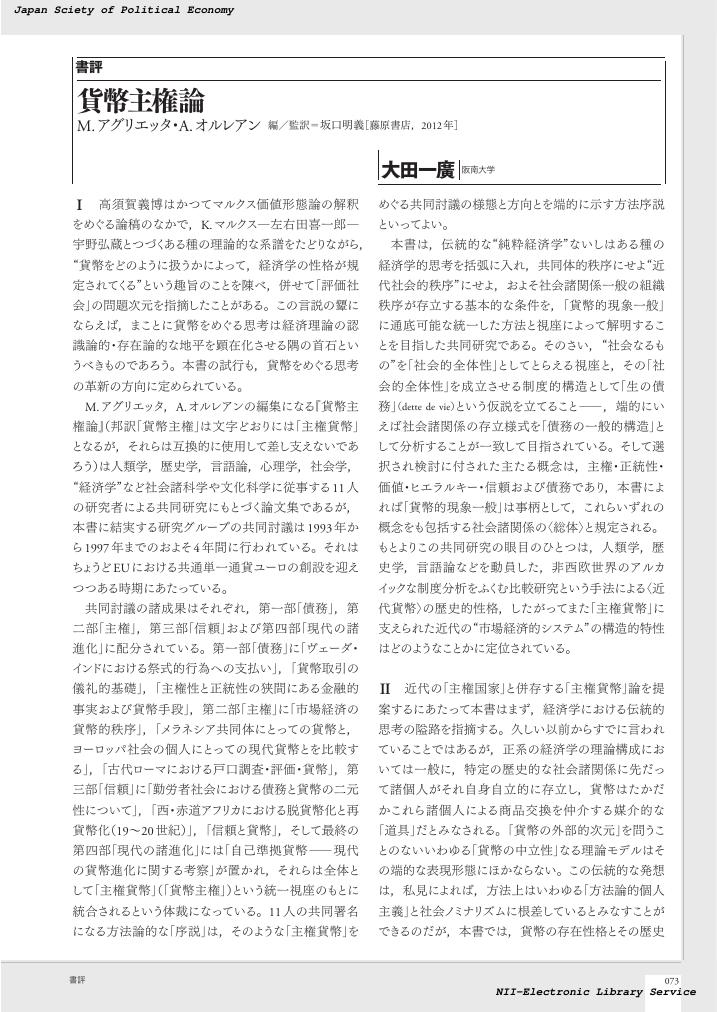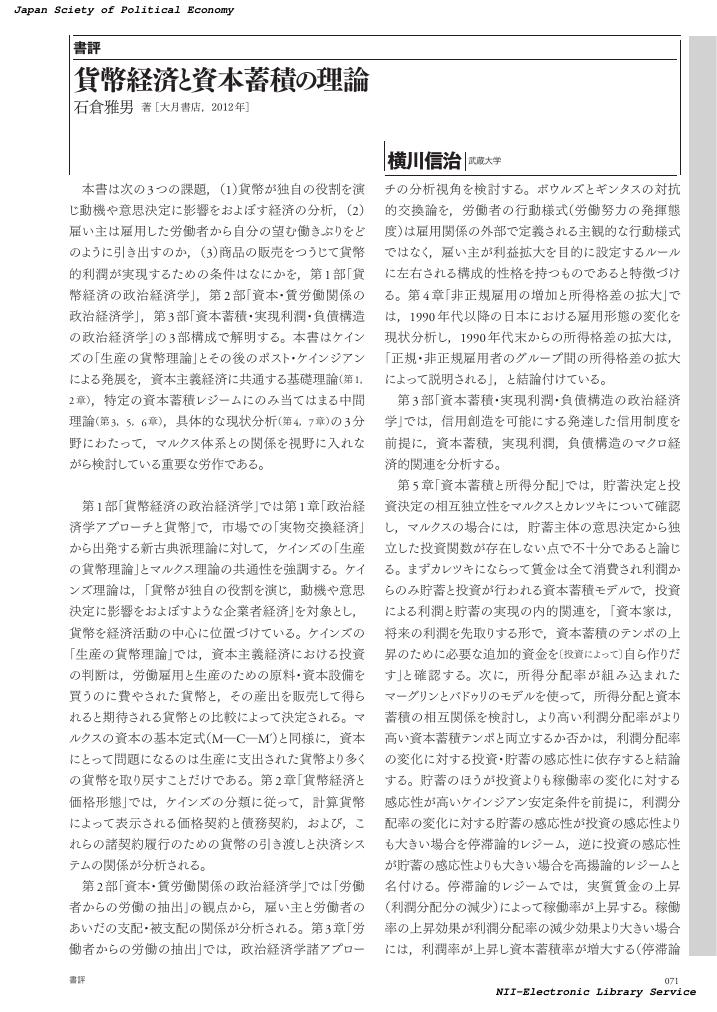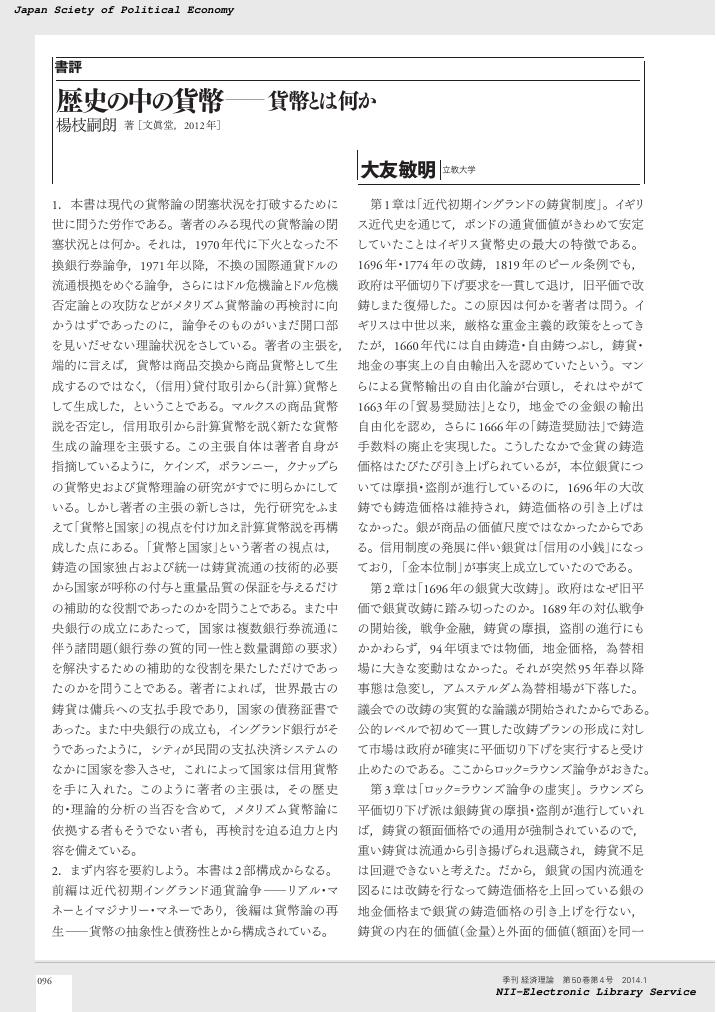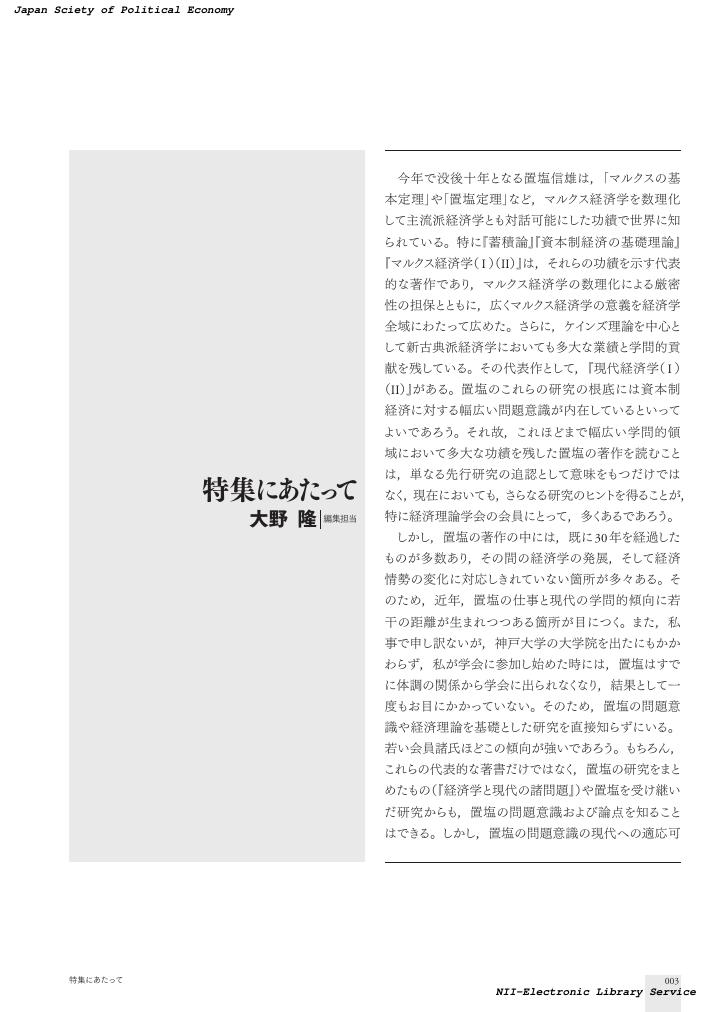1 0 0 0 OA 家事労働とマルクス剰余価値論, 森田成也著, [桜井書店, 2014年]
- 著者
- 佐藤 拓也
- 出版者
- 経済理論学会
- 雑誌
- 季刊経済理論 (ISSN:18825184)
- 巻号頁・発行日
- vol.52, no.4, pp.95-97, 2016-01-20 (Released:2018-01-09)
- 著者
- 佐藤 秀夫
- 出版者
- 経済理論学会
- 雑誌
- 季刊経済理論 (ISSN:18825184)
- 巻号頁・発行日
- vol.52, no.2, pp.107-109, 2015
- 著者
- 宮川 彰
- 出版者
- 経済理論学会
- 雑誌
- 季刊経済理論 (ISSN:18825184)
- 巻号頁・発行日
- vol.51, no.2, pp.31-41, 2014-07-20
The core of progress in the formative history of Das Kapital the second volume during Marx's last years was when he reached his ultimate critique about "Smith's Dogma", classical reproduction theory, by finishing the theory of circuits of capital, and developed an original new paradigm on the theory of reproduction. Until the second manuscript(1868-1870) he could not overcome the concept of capital-revenue transformation and resolve the value-theory of the classical school so his discussion was limited within the framework of the means of consumption sector-led dogma that has the stand point of a money-veil view, but by finishing 5-7 manuscripts of the circuits of capital in late 1870', he made the discovery of multilayered ties between capital(/revenue) and general commodity circulation, as well as a mutual relationship between money-capital and money. Furthermore, he found that capital itself circulates and by this(working as a lever) he could finally overthrow the classical theory of reproduction based on dogma and achieve the accomplishment of establishing his original theory, the theory of reproduction based on the circuits of capital. In the discussion of formative history for the second volume, the evaluation of Marx's step regarding the theory of reproduction, 2 conflicting opinions between the one way of "understanding of manuscripts in gradual consistency" and the other way of "grasping of a drastic theoretical development" are rekindled. It depends on how the process is seen but the fact is that Marx clearly denied his former way of understanding the classical concept of capital-revenue transformation and of resolving the theory of value Dogma. In this report, using clues from the publication of drafts of the MEGA second section 11^<th> volume, the 8^<th> manuscript was found to be the watershed in which it can clearly be seen how Marx overcame the dictates of classical Dogma and, as a result, it can be concluded "the grasping a final drastic development in the 8^<th> manuscript" is correct.
- 著者
- 小倉 将志郎
- 出版者
- 経済理論学会
- 雑誌
- 季刊経済理論 (ISSN:18825184)
- 巻号頁・発行日
- vol.48, no.4, pp.98-100, 2012-01-20 (Released:2017-04-25)
- 著者
- 佐藤 隆
- 出版者
- 経済理論学会
- 雑誌
- 季刊経済理論 (ISSN:18825184)
- 巻号頁・発行日
- vol.51, no.4, pp.96-98, 2015
1 0 0 0 OA 改めて,私たちは市場とどのように向き合うべきか(<特集>調和する社会の諸相)
- 著者
- 佐藤 良一
- 出版者
- 経済理論学会
- 雑誌
- 季刊経済理論 (ISSN:18825184)
- 巻号頁・発行日
- vol.50, no.3, pp.20-30, 2013-10-20 (Released:2017-04-25)
The difference of the idea in economics stems from the approach to the question: how to answer the mechanism of a market. The financial crisis in 2008 could be interpreted as the end of 'Market fundamentalism', however, the situations has been almost the same before the crisis. The 'market' is still the subject when businessmen talk about the economic problems. We have to tackle with the fundamental question: what is the core for ordinary people who sell labor-power for their subsistence. This paper consists as follows. In section I the argument of 'How market crowd out morals' by Sandel, the critics by Bowels and Gintis, and the reply to them are introduced. Needless to say, the fundamental unit, which organizes a society, should be a human being. The hypothesis on its behavior is indispensable for an economic theory. Neoclassical theory adopts the assumption of so-called homo-economicus. An alternative to this is 'Reciprocans', which is presented by US radicals. The distinction between these two is examined in the section II. When we try to present an alternative to the status quo from the viewpoint of 'a harmonious society', the development of the situation must be confirmed correctly. The recent change of the wage share in the US shows the severe conditions for working people. Assuming the capitalist way of management, the fundamental relations between capital and labor cannot be harmonious but conflict. As a Keynes model teaches us, the real wage rate must be reduced when the capitalist increase the employment. Profit maximization can be satisfied when the real wage rate is equal to the marginal product of labor. According to this condition, the inverse relation between an employment and real wage holds. Regrettably new prospects for an alternative won't be opened unless we could succeed in making some drastic change. If we pursue the harmony among people, the point is the feasibility of an alternative and the potential path to a 'new society'. For the present, we have to take a realist view of 'capitalist' economy. This means that we have to change the capitalist way of management step by step(section III).
- 著者
- 大田 一廣
- 出版者
- 経済理論学会
- 雑誌
- 季刊経済理論 (ISSN:18825184)
- 巻号頁・発行日
- vol.50, no.3, pp.73-75, 2013-10-20 (Released:2017-04-25)
1 0 0 0 グローバル資本主義の段階論的解明−現代資本主義論の理論と方法
- 著者
- 二宮 健史郎
- 出版者
- 経済理論学会
- 雑誌
- 季刊経済理論 (ISSN:18825184)
- 巻号頁・発行日
- vol.46, no.4, pp.25-33, 2010-01-20 (Released:2017-04-25)
There has been antagonism between neo-classical and Keynesian macroeconomics since the 1980s. Neo-classical economists have criticized the IS-LM model for reasons such as lacking a microeconomic foundation and assuming price stickiness. Neo-classical and Keynesian economics also hold differing theories of interest rate. In short, neo-classical economics adopts the saving-investment theory of interest rate determination, whereas Keynesian macroeconomics adopts the liquidity preference theory. Mankiw (1992) proposed a macroeconomic model in the short and long run. He interpreted the IS equation as the saving-investment theory of interest rate and the LM equation as the quantity theory of money. Romer (2000) and Taylor (2004) presented another macroeconomic model in which a monetary policy rule was introduced in place of the LM equation. Romer (2000) and Taylor (2004) abandoned any differing theory of interest rate between neo-classical and Keynesian economics. On the other hand, Minsky (1982; 1986) who was a heavyweight in post-Keynesian economics proposed the financial instability hypothesis, which emphasized how the complicated financial structure underlying the capitalist economy generates business fluctuations and cycles. Many non-neo-classical economists have developed his idea following Taylor and O'Connell (1989) who proved that an economy would fall into a financial crisis when a decline in expected profit rates aggravated the financial condition of firms and increased households' preference for liquidity. Recent studies by Asada (2006) and Ninomiya and Sanyal (2009) have incorporated the dynamic equation of debt burden of firms into nonlinear economic dynamic models to indicate the financial condition. Following Rose (1969) and Okishio (1986), Ninomiya (2007c) adopted the loanable fund theory and discussed financial instability in an oligopolistic (or short run) economy. This paper examines financial instability in macroeconomics in the short and long run. We adopt the loanable fund theory to integrate neo-classical and Keynesian economics in order to evaluate the post-Keynesians' analysis of financial instability.
1 0 0 0 OA 金融危機下の日銀の金融政策, 建部正義著, 中央大学出版部, 2010年
- 著者
- 前畑 雪彦
- 出版者
- 経済理論学会
- 雑誌
- 季刊経済理論 (ISSN:18825184)
- 巻号頁・発行日
- vol.48, no.1, pp.86-88, 2011-04-20 (Released:2017-04-25)
- 著者
- 建部 正義
- 出版者
- 経済理論学会
- 雑誌
- 季刊経済理論 (ISSN:18825184)
- 巻号頁・発行日
- vol.51, no.3, pp.101-104, 2014-10-20 (Released:2017-04-25)
1 0 0 0 OA 21世紀型世界経済危機と金融政策, 建部正義著, [新日本出版社, 2013年]
- 著者
- 米田 貢
- 出版者
- 経済理論学会
- 雑誌
- 季刊経済理論 (ISSN:18825184)
- 巻号頁・発行日
- vol.50, no.4, pp.117-120, 2014-01-20 (Released:2017-04-25)
1 0 0 0 OA 貨幣経済と資本蓄積の理論, 石倉雅男著, 大月書店, 2012年
- 著者
- 横川 信治
- 出版者
- 経済理論学会
- 雑誌
- 季刊経済理論 (ISSN:18825184)
- 巻号頁・発行日
- vol.51, no.1, pp.71-73, 2014-04-20 (Released:2017-04-25)
- 著者
- 植村 博恭
- 出版者
- 経済理論学会
- 雑誌
- 季刊経済理論 (ISSN:18825184)
- 巻号頁・発行日
- vol.52, no.1, pp.4-21, 2015-04-20 (Released:2017-04-25)
In order to reconstruct the economic theory, we should develop our study on the basis of existing achievements with an intentionally refreshed methodological approach. We have developed "the institutional analysis of socio-economic systems" which integrates the regulation theory, the Post-Keynesian theory and the Radical Economics theory. We have also developed collaborative researches with the various economics of institutions and evolution, and have published books such as the Japanese version of S. Bowles's Microeconomics: Behavior, Institutions and Evolution as well as R. Boyer, H. Uemura, and A. Isogai (eds.) Diversity and Transformations of Asian Capitalisms. The aim of this paper is to investigate how we can reconstruct the economic theory, surveying and assessing the results of our collaborative researches from the theoretical point of view. We especially focus on following points. First, the methodology of this theoretical investigation is proposed, while referring to E. Sugimoto'concept of "modern economics" to emphasize the importance of productive academic discussion. Furthermore, it is pointed out that productive discussions have not been promoted due to the dominance of "the Neo-Classical paradigm". Second, after investigating the basic assumptions of the Neo-Classical paradigm, the academic significance and intrinsic theoretical problems of Marx and Keynes are considered, and it is shown how the Post-Marxian and the Post-Keynesian have tried to overcome their problems. Third, based on the recent development of the economics of institutions and evolution, we show our own research agendas on following subjects: mutually determining relations between institutions/macro processes and the behaviors of agents, meso-level coordinating mechanisms, relationships between the financial system and wage-labor nexus, the institutional varieties of capitalism. Fourth, the recent studies of price and wage determination, the financial system and international trade in contemporary capitalism are assessed thoroughly, and the new achievements of researches by the regulation theory and the contemporary Classical trade theory are studied to reconstruct the economic theory.
1 0 0 0 OA 歴史の中の貨幣-貨幣とは何か, 楊枝嗣朗著, [文眞堂, 2012年]
- 著者
- 大友 敏明
- 出版者
- 経済理論学会
- 雑誌
- 季刊経済理論 (ISSN:18825184)
- 巻号頁・発行日
- vol.50, no.4, pp.96-98, 2014-01-20 (Released:2017-04-25)
1 0 0 0 OA 資本主義の成熟と転換-現代の信用と恐慌, 小西一雄著, [桜井書店, 2014年]
- 著者
- 建部 正義
- 出版者
- 経済理論学会
- 雑誌
- 季刊経済理論 (ISSN:18825184)
- 巻号頁・発行日
- vol.52, no.2, pp.110-112, 2015-07-20 (Released:2017-07-03)
1 0 0 0 OA 『国際過剰資本の誕生』, 板木雅彦著, ミネルヴァ書房, 2006年
- 著者
- 上川 孝夫
- 出版者
- 経済理論学会
- 雑誌
- 季刊経済理論 (ISSN:18825184)
- 巻号頁・発行日
- vol.43, no.4, pp.89-91, 2007-01-20 (Released:2017-04-25)
- 著者
- 大内 秀明
- 出版者
- 経済理論学会
- 雑誌
- 季刊経済理論 (ISSN:18825184)
- 巻号頁・発行日
- vol.51, no.1, pp.86-88, 2014-04-20 (Released:2017-04-25)
1 0 0 0 OA 特集にあたって(<特集>置塩経済学の可能性)
- 著者
- 大野 隆
- 出版者
- 経済理論学会
- 雑誌
- 季刊経済理論 (ISSN:18825184)
- 巻号頁・発行日
- vol.50, no.4, pp.3-4, 2014-01-20 (Released:2017-04-25)
- 著者
- 小幡 道昭
- 出版者
- 経済理論学会
- 雑誌
- 季刊経済理論 (ISSN:18825184)
- 巻号頁・発行日
- vol.48, no.1, pp.15-25, 2011-04-20 (Released:2017-04-25)
The paper argues that theoretical framework of Marxian economics should be rebuilt under the rise of newly emerging capitalism such as China, India and Brazil. Based on the recognition that the setback of neo-liberalism revealed by the collapse of Lehman Brothers in 2008 is not the end of globalism, but the beginning of the full-fledged development of globalization, we have fundamentally changed the stage theory of historical development of capitalism which insists that capitalism has a single origin and goes through three stages of generation, development and decline, into the Multilayered Origins Theory of Capitalism such that different types of capitalism swarms intermittently in different regions. It tells us that structural change comparable to the rise of England with decline of the Netherlands, the subsequent rise of Germany with decline of Britain, is now happening between the advanced capitalist countries in the 20th century and emerging economies in the 21st century. Such understanding about the history of capitalist development requires abolishing the single image of capitalism based on the theory of pure capitalism such as Kozo Uno proposed. Here we examined three aspects of his idea, (1) significance of dividing theory into two layers, (2) limitations of the idea of closing to and leaving from the pure state of capitalism, and (3) inconsistency in dividing stages into mercantilism, liberalism and imperialism. Alternatively after illustrating the Transformation Approach focused on structural changes in capitalism, we try to check the validity of the theory by studying three contemporary issues, namely, employment, environment and private property of knowledge and information. It leads us to the idea of maturity in advanced capitalism after neo-liberalism. Matured capitalism, though flexible to change with dismantling the social relations and spreading ideology that persuade people to think it natural, still cannot return to welfare state capitalism in 20th century under the rise of emerging capitalism. It has no choice without neo-socialism.












